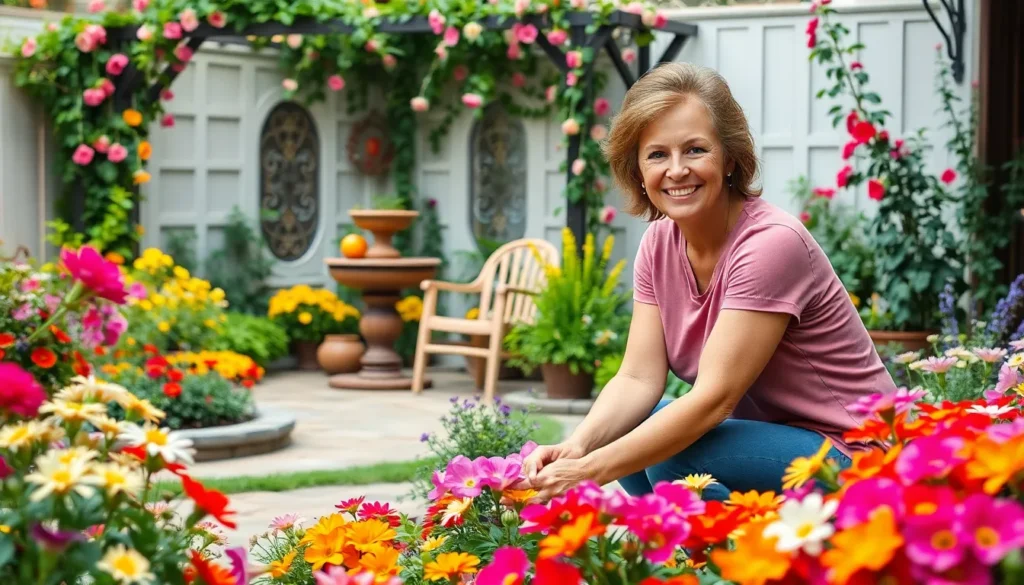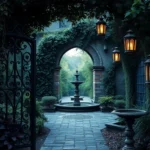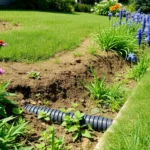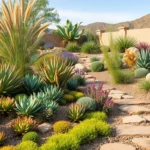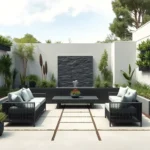Transform your outdoor space into a stunning sanctuary with creative garden area ideas that’ll make your neighbors envious. Whether you’re working with a sprawling backyard or a compact urban plot, we’ve discovered countless ways to maximize every square foot and create distinct zones that serve different purposes.
From cozy reading nooks tucked between fragrant herbs to vibrant entertainment areas perfect for weekend gatherings, your garden can become so much more than just a patch of grass. We’ll show you how to blend functionality with beauty, creating spaces that reflect your personality while boosting your home’s value.
Ready to turn that underutilized corner into your favorite retreat? Let’s explore innovative design concepts that’ll help you create the garden of your dreams without very costly.
Transform Your Front Yard Into a Welcoming Garden Oasis
Your front yard serves as the first impression visitors get of your home, making it the perfect canvas for creating a stunning garden oasis. Building on the foundation of thoughtful outdoor design, we’ll explore exact front yard transformations that enhance curb appeal while establishing a warm, inviting atmosphere.
Create Colorful Flower Borders Along Walkways
Colorful flower borders transform ordinary walkways into enchanting garden pathways that guide visitors to your front door. Plant seasonal blooms like marigolds, petunias, and impatiens in spring for vibrant colors that last through summer. Choose perennial options such as lavender, salvia, and black-eyed Susans to reduce replanting needs while maintaining year-round structure.
Design your borders with varying heights by placing taller plants like delphiniums and hollyhocks toward the back, medium-height flowers such as zinnias and cosmos in the middle, and low-growing options like alyssum and lobelia along the front edge. This layered approach creates visual depth and ensures all plants receive adequate sunlight.
Consider the bloom times when selecting flowers to maintain continuous color throughout the growing season. Early spring bulbs like tulips and daffodils provide initial color, followed by summer annuals, and finished with fall-blooming chrysanthemums and asters.
Install Low-Maintenance Succulent Gardens
Low-maintenance succulent gardens offer drought-resistant beauty that thrives with minimal care, making them perfect for busy homeowners. Select hardy varieties like sedums, hens and chicks, and jade plants that tolerate various weather conditions while providing interesting textures and forms throughout the year.
Group succulents with similar water and light requirements together to create cohesive planting zones that simplify maintenance routines. Arrange different sizes and colors in clusters, using larger specimens like agave or barrel cactus as focal points surrounded by smaller varieties such as echeveria and string of pearls.
Improve drainage by adding gravel or sand to existing soil, as most succulents require well-draining conditions to prevent root rot. Create raised beds or use decorative rocks and pebbles as mulch to enhance the desert garden aesthetic while protecting plant roots from excess moisture.
Design Eye-Catching Container Garden Displays
Eye-catching container garden displays provide flexibility to change your front yard’s appearance seasonally while adding vertical interest to flat landscapes. Choose containers of varying heights, materials, and colors to create ever-changing groupings that complement your home’s architectural style.
Mix different plant types within each container using the thriller, filler, and spiller technique: place tall, dramatic plants like ornamental grasses or small trees as thrillers, add medium-sized flowering plants as fillers, and include trailing varieties such as ivy or petunias as spillers that cascade over container edges.
Position containers strategically near your front entrance, along porch steps, or flanking walkways to create natural focal points that draw the eye toward your home. Rotate seasonal plantings throughout the year, switching from spring bulbs to summer annuals to fall mums and winter evergreens for continuous appeal.
Design a Peaceful Meditation Garden Retreat
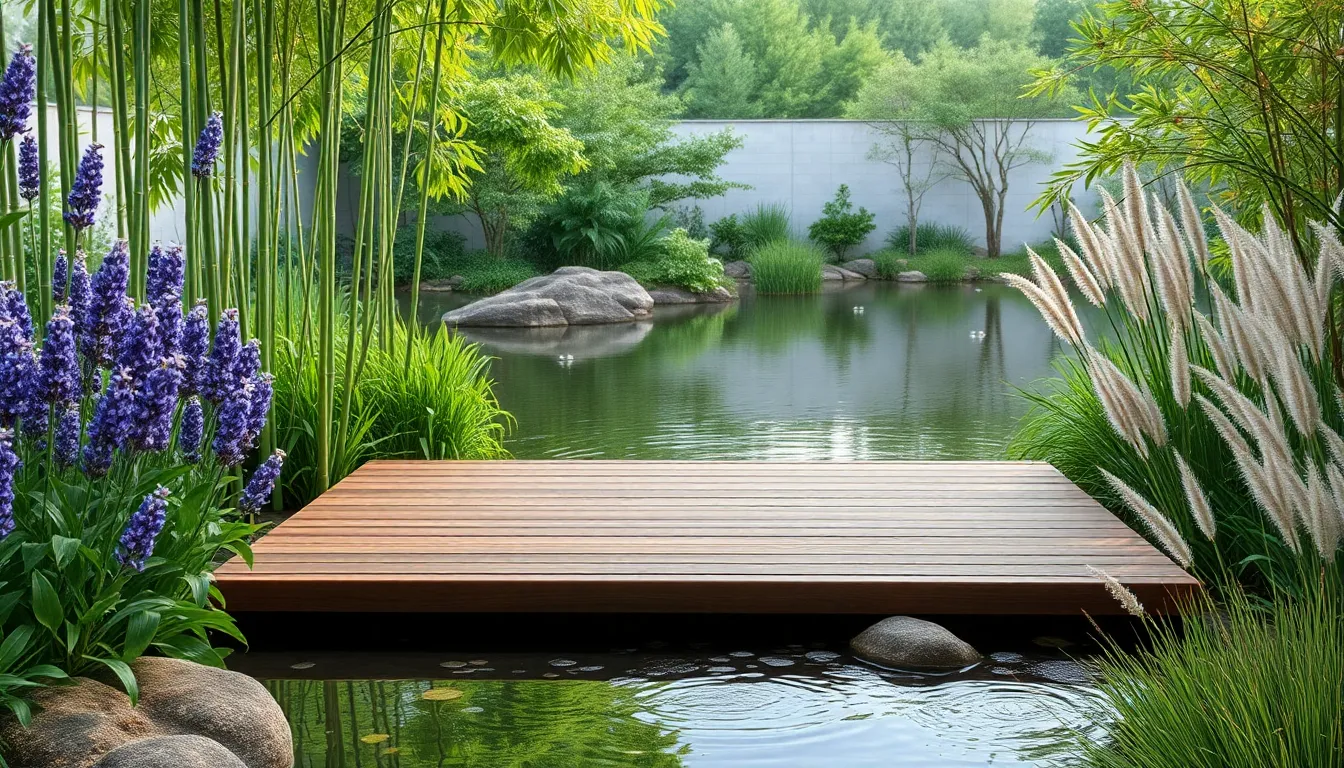
Building on your garden transformation journey, we’ll explore how to create a tranquil sanctuary that promotes mindfulness and relaxation. This dedicated space offers a perfect escape from daily stress while adding unique value to your outdoor design.
Choose Calming Plants Like Lavender and Bamboo
Lavender transforms any meditation space with its naturally calming scents and soothing purple hues that promote relaxation. We recommend planting varieties like English lavender or French lavender along pathways where you’ll brush against them during walks.
Bamboo creates the perfect natural soundtrack as it sways gently in breezes while requiring minimal maintenance throughout the year. Clumping bamboo varieties like Buddha’s Belly or Fountain Bamboo work best for contained meditation gardens without spreading concerns.
Jasmine and chamomile complement these primary plants by adding soft fragrances and delicate blooms that enhance the sensory meditation experience. Plant these aromatic options near seating areas where their scents can be most appreciated.
Add Water Features for Soothing Sounds
Ponds establish a focal point that creates gentle rippling sounds while reflecting sky and surrounding plants for visual depth. We suggest designing kidney shaped or circular ponds with depths of 18 to 24 inches for optimal sound production.
Fountains provide consistent water sounds that effectively mask traffic noise and neighborhood distractions during meditation sessions. Tiered stone fountains or simple bamboo water spouts offer different sound textures to match your garden’s aesthetic.
Small waterfalls generate the most natural sounds by cascading water over rocks or stone ledges into collection pools below. Building these features with local stone materials helps them blend seamlessly into the industry design.
Create Secluded Seating Areas with Natural Materials
Stone benches offer permanent seating answers that weather naturally while providing sturdy support for extended meditation periods. We recommend using sandstone or limestone that matches your local geology for authentic integration.
Wooden platforms create elevated meditation spaces using cedar or teak materials that resist moisture while aging gracefully over time. These raised areas work especially well in gardens with drainage concerns or uneven terrain.
Bamboo structures provide lightweight privacy screens that filter views while maintaining airflow around seating areas. Incorporate bamboo trellises or living bamboo hedges to establish intimate spaces without blocking natural light completely.
Natural privacy elements like shrubs and ornamental grasses create gentle boundaries that define meditation zones without harsh lines. We suggest using feather grass or fountain grass that moves softly in breezes while providing visual separation.
Build Functional Raised Bed Vegetable Gardens
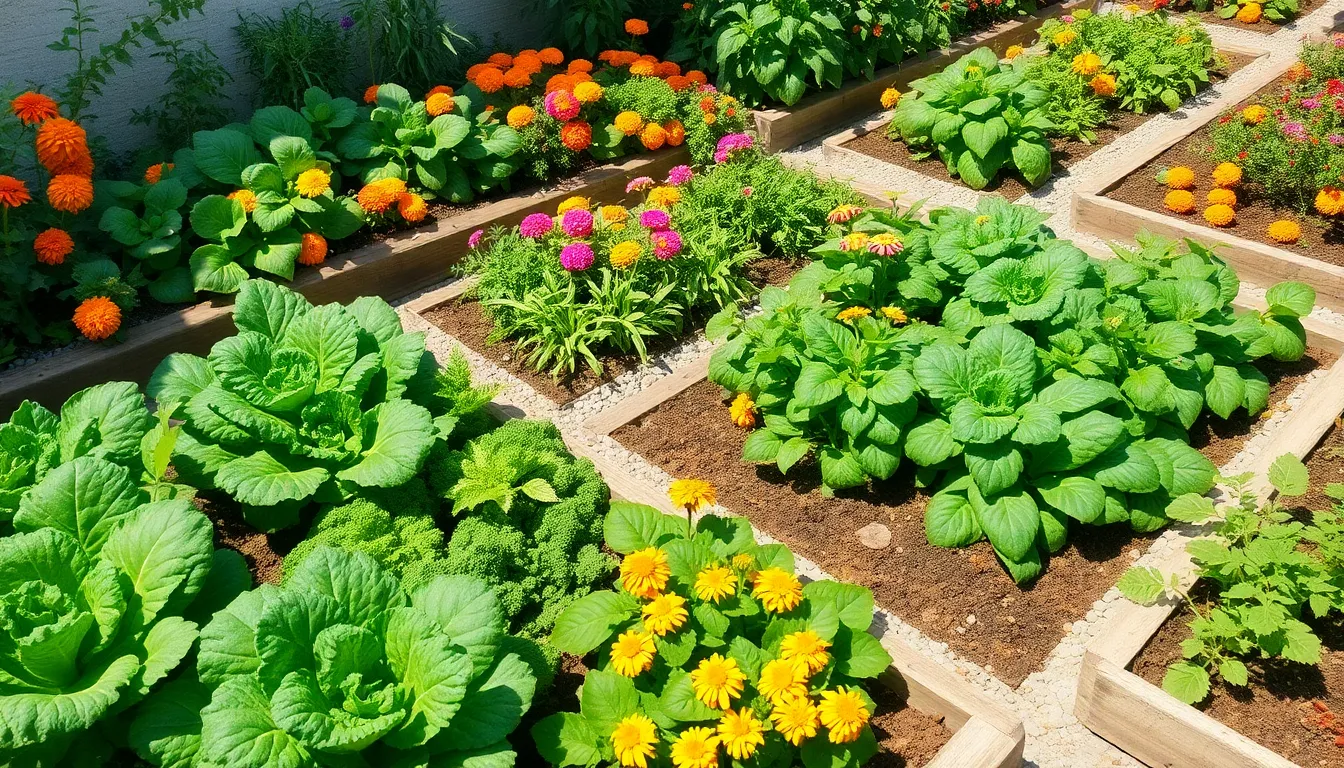
Moving beyond ornamental spaces, we’ll explore how raised bed vegetable gardens combine beauty with function. These elevated growing areas offer excellent drainage and nutrient-rich soil conditions that make vegetable gardening more accessible and productive.
Plan Efficient Layout for Maximum Harvest
Strategic planning transforms limited garden space into a highly productive growing area. We recommend creating four raised beds arranged symmetrically with pathways between them, which enables easy access while supporting effective crop rotation practices.
Dedicated beds for exact plant types maximize both space efficiency and garden health. Leafy greens thrive in one bed while root vegetables flourish in another, and fruiting crops receive their own dedicated growing space. This separation approach simplifies pest management and maintains optimal soil conditions for each plant category.
Pathways between beds should measure at least 2 feet wide to accommodate comfortable walking and maintenance access. Multiple beds allow for intensive planting methods that pack diverse plant varieties into compact spaces, significantly increasing overall harvest yields.
Select Easy-to-Grow Vegetables for Beginners
Beginning gardeners benefit from choosing vegetables that require minimal maintenance while delivering reliable harvests. Leafy greens like lettuce, Swiss chard, and kale establish quickly and provide continuous harvests throughout the growing season.
Root crops including radishes and carrots adapt well to raised bed conditions and mature relatively quickly. Peas offer easy cultivation with the added benefit of fixing nitrogen in the soil, improving conditions for subsequent plantings.
Tomatoes, peppers, and herbs like parsley and basil provide excellent options for new gardeners seeking flavorful additions to their kitchens. These plants generally tolerate varying conditions while producing abundant harvests that justify the initial investment in raised bed construction.
Incorporate Companion Planting Strategies
Companion planting maximizes garden productivity by pairing plants that support each other’s growth and health. Marigolds planted alongside tomatoes and cabbage create natural pest deterrent systems that reduce the need for chemical interventions.
Nasturtiums serve as excellent companion plants near beans and cabbage, effectively repelling harmful insects while attracting beneficial pollinators. These flowering plants add visual appeal while serving functional purposes in vegetable garden designs.
Mixing herbs, flowers, and vegetables within raised beds creates diverse ecosystems that attract pollinators and beneficial insects. This plant diversity approach improves overall garden health while increasing yields through enhanced pollination and natural pest control mechanisms.
Create Vertical Garden Spaces for Small Areas
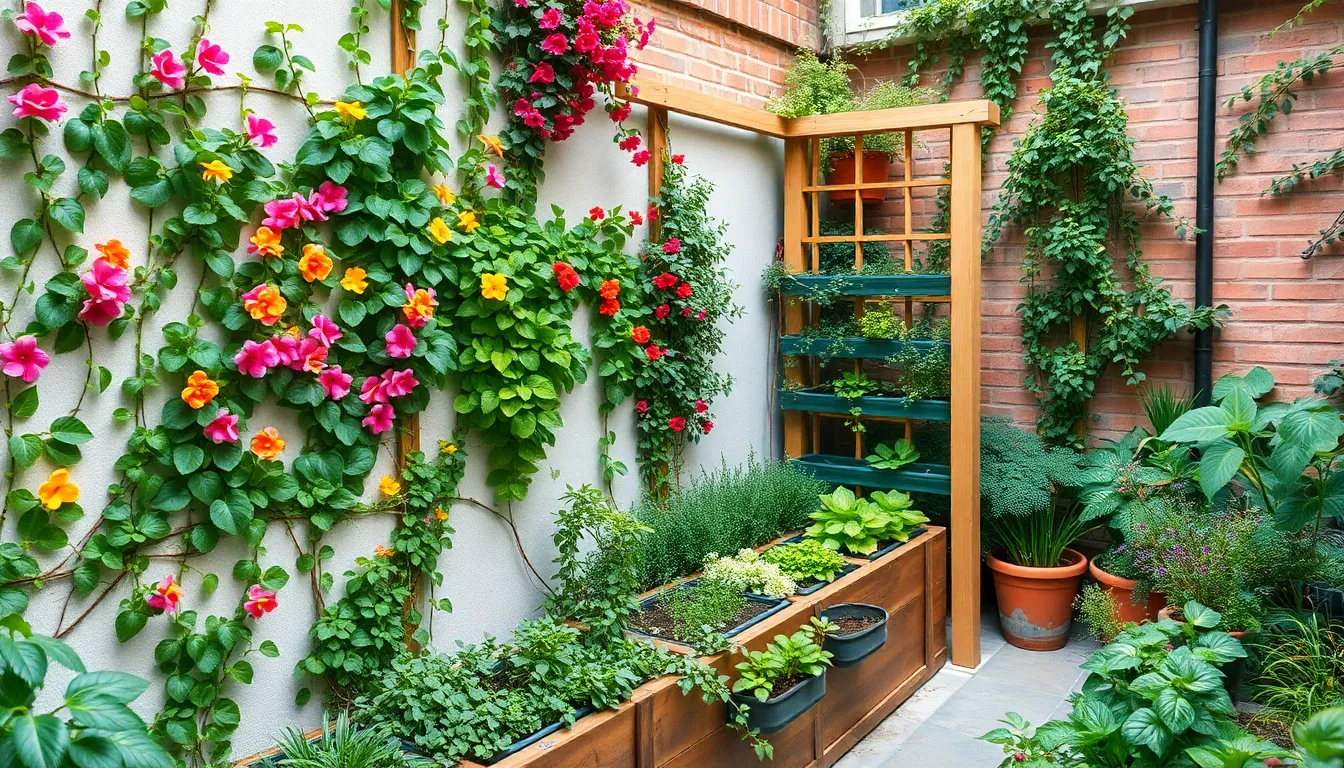
Vertical gardening transforms limited outdoor spaces into thriving green environments by utilizing wall space instead of valuable floor area. These innovative systems work perfectly for balconies, patios, and small yards where ground space is at a premium.
Install Living Walls with Climbing Plants
Living walls create stunning vertical features that dramatically improve air quality while adding natural beauty to urban environments. We recommend selecting climbing plants like ivy, jasmine, and clematis that require minimal ground space yet provide excellent coverage and vibrant color throughout growing seasons.
Best Climbing Plants for Living Walls:
| Plant Type | Coverage Speed | Maintenance Level | Visual Impact |
|---|---|---|---|
| Ivy | Fast | Low | Year-round green |
| Jasmine | Medium | Medium | Fragrant flowers |
| Clematis | Medium | Medium | Colorful blooms |
These green wall systems reduce urban heat significantly while creating natural sound barriers. Epiphytes and other air plants can supplement climbing varieties to add textural interest without additional soil requirements.
Use Trellises and Arbors for Vertical Interest
Trellises support productive climbing plants like beans, peas, and cucumbers while creating defined garden spaces with visual appeal. We’ve found that wooden, metal, or bamboo structures install easily along existing fences or within garden beds to maximize growing potential.
Arbors serve dual purposes by supporting flowering vines and edible climbers while creating attractive entryways or focal points. These vertical structures increase garden yield substantially in compact areas by utilizing unused vertical space effectively.
Ideal Plants for Trellis Systems:
- Edible climbers: beans, peas, cucumbers, squash
- Flowering vines: morning glories, sweet peas, climbing roses
- Perennial options: grape vines, hardy kiwi, climbing hydrangeas
Maximize Space with Tiered Planting Systems
Tiered systems use shelves, racks, and multi-level planters to create compact growing environments with optimal sunlight distribution for each plant layer. We position these systems to ensure proper air circulation between levels while maintaining easy access for maintenance and harvesting.
Perfect Plants for Tiered Gardens:
| Plant Category | Examples | Space Requirements | Light Needs |
|---|---|---|---|
| Herbs | Basil, oregano, thyme | 6-8 inches | Full sun |
| Strawberries | Ever-bearing varieties | 8-10 inches | Partial sun |
| Compact vegetables | Lettuce, cherry tomatoes | 10-12 inches | Full sun |
These multi-level arrangements accommodate diverse plant types while maintaining organized growing spaces. Stackable containers and hanging planters integrate seamlessly with tiered systems to create comprehensive vertical gardens that free up floor space for seating areas and walkways.
Establish Natural Wildlife Habitat Gardens
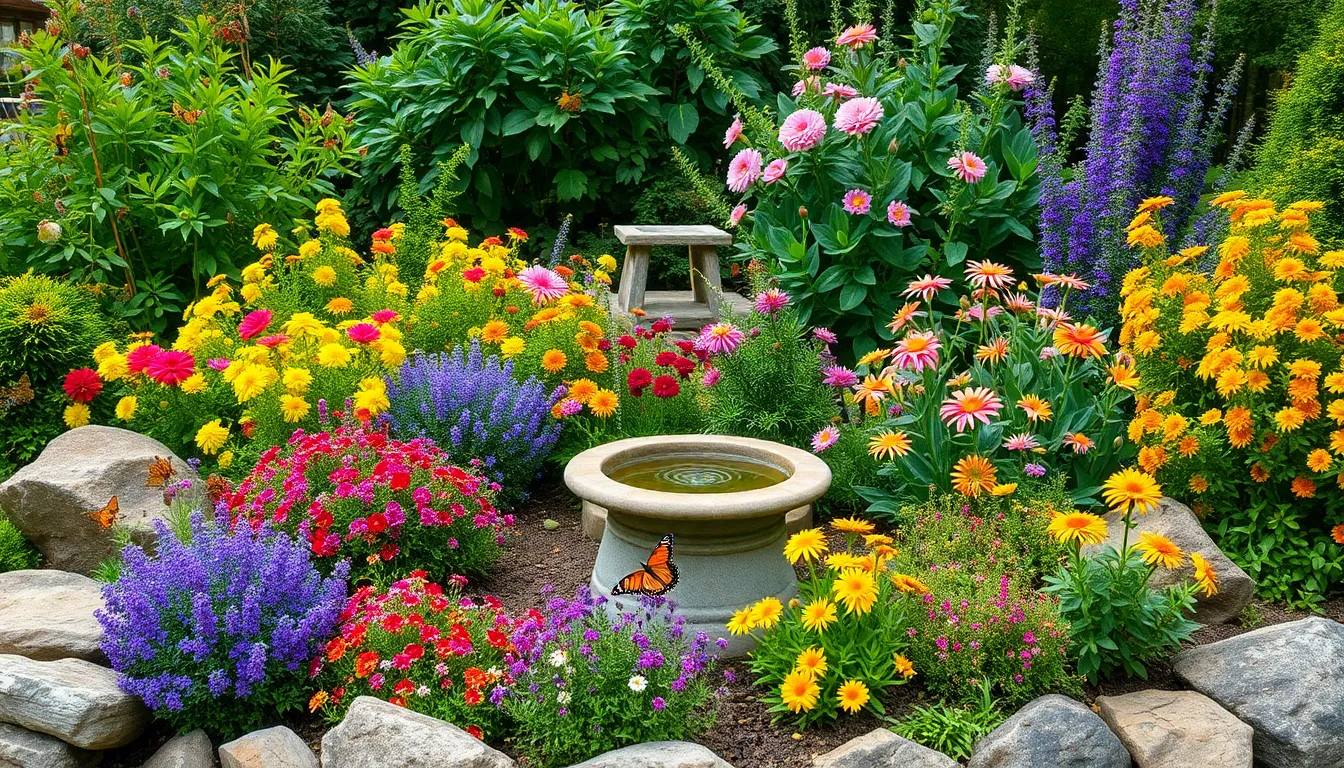
Natural wildlife habitat gardens transform unused spaces into thriving ecosystems that support local fauna while creating stunning industry features. We’ll help you design garden areas that benefit both wildlife and your outdoor aesthetic.
Plant Native Species to Attract Local Wildlife
Native plants form the foundation of successful wildlife habitat gardens because they’re adapted to local conditions and provide essential food sources for indigenous species. We recommend converting sections of traditional lawn into diverse plantings featuring native trees, shrubs, and herbaceous perennials that support insects, birds, and small mammals throughout the year.
Create multi-layered arrangements that mimic natural ecosystems by combining ground covers, mid-height plants, and taller shrubs or trees. This approach provides varied microhabitats for shelter, nesting, and feeding opportunities while adding visual depth to your garden design.
Group plants with similar requirements together by matching their sunlight and water needs for easier maintenance and healthier growth. Habitat hedgerows and drifts of native flowers, grasses, and ferns can define garden edges while offering shelter and forage for different species.
Add natural materials like rocks, logs, and branches along pathways or garden edges to provide hiding spots and microhabitats for amphibians and small animals. Leave some leaf litter in designated areas for ground-dwelling species, which helps maintain biodiversity while reducing maintenance requirements.
Install Bird Baths and Feeding Stations
Bird baths serve as essential water sources and attractive focal points that draw various wildlife species to your garden area. Even simple bird baths provide critical hydration for birds and other animals while creating opportunities for wildlife observation.
Position feeding stations strategically near shrubs or trees to offer both food and protection from predators. Native seeds and fruits in feeders attract local bird species while supporting their natural dietary needs throughout different seasons.
Maintain consistent water sources by cleaning bird baths regularly and ensuring fresh water availability, especially during dry periods when natural water sources may be scarce.
Create Butterfly Gardens with Nectar-Rich Flowers
Butterfly gardens featuring nectar-rich flowers native to your region provide vital support for adult butterflies and other pollinators. We suggest selecting plants with different bloom times to ensure continuous nectar availability throughout the growing season.
Choose diverse flowering plants that bloom in succession from spring through fall, creating an extended buffet for butterflies and beneficial insects. Native wildflowers, perennial herbs, and flowering shrubs work together to support various pollinator species.
Design clustered plantings rather than scattered individual plants to create more impactful visual displays and make it easier for butterflies to locate food sources. These concentrated nectar sources also reduce the energy butterflies expend while foraging.
Include host plants alongside nectar sources to support complete butterfly lifecycles, allowing caterpillars to develop while adult butterflies feed and reproduce in your garden habitat.
Design Themed Garden Areas for Visual Interest
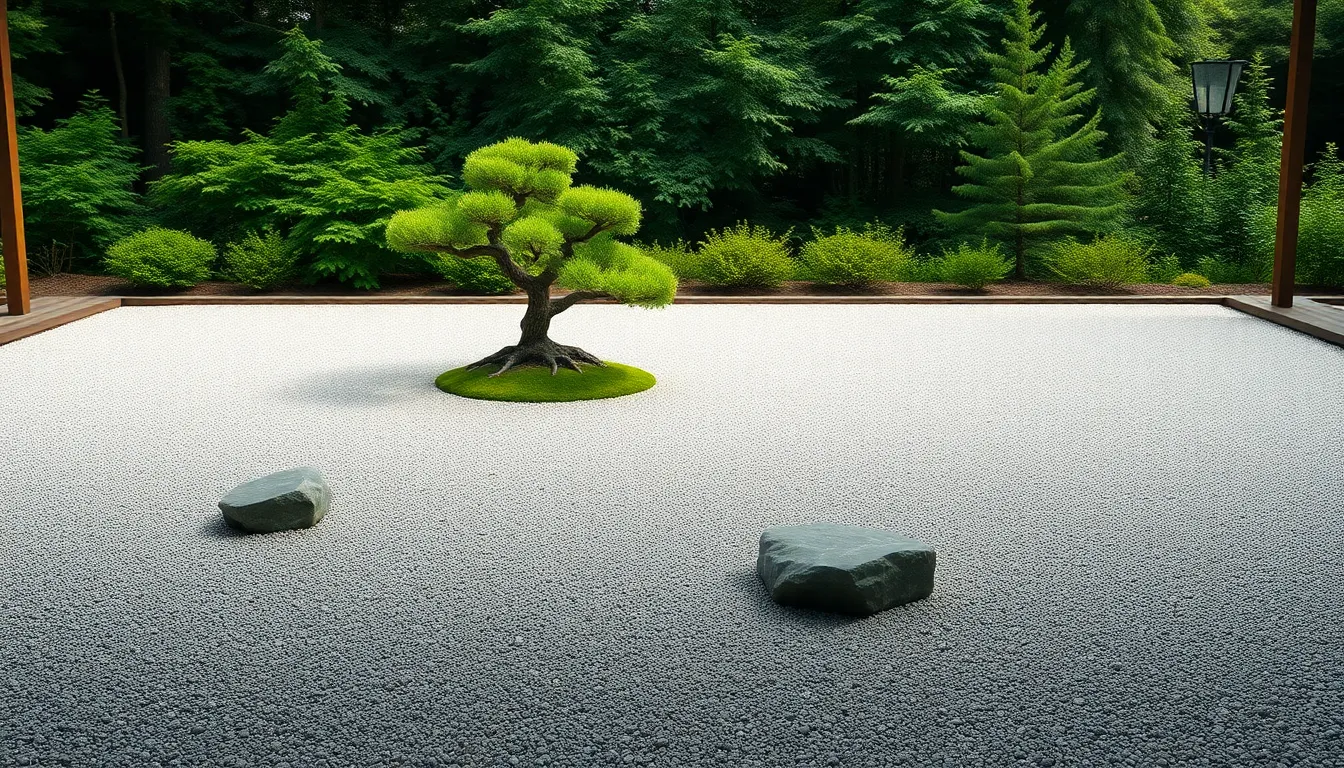
We can transform any outdoor space into a captivating industry by incorporating distinct themed areas that reflect our personal style while creating visual drama. Strategic themed design allows us to establish dedicated zones that serve different purposes while maintaining overall garden cohesion.
Plan Japanese-Inspired Zen Gardens
Japanese zen gardens emphasize austerity, simplicity, naturalness, asymmetry, mystery, unworldly thoughts, and stillness as core design principles. We should incorporate key elements like strategically placed rocks, carefully raked gravel patterns, patches of moss, and select plants such as bonsai or Japanese maples to create authentic zen spaces.
Gravel patterns become symbolic representations of water or natural landscapes when we rake them in flowing, asymmetrical designs. Rock placement requires thoughtful consideration since each stone should appear naturally positioned while serving a exact visual purpose within the overall composition.
Plant selection focuses on species that enhance the meditative quality rather than compete for attention. We can choose low maintenance options like ornamental grasses, ferns, and small evergreen shrubs that complement the minimalist aesthetic while requiring minimal intervention.
Create English Cottage Garden Charm
English cottage gardens feature abundant mixtures of colorful perennials, fragrant herbs, and climbing plants that create cozy, inviting atmospheres throughout growing seasons. We should combine vibrant flowers with lush greenery, incorporating rustic pathways and charming garden ornaments like sundials or bird baths for authentic cottage appeal.
Layered planting techniques work best when we mix heights, textures, and bloom times to ensure continuous seasonal interest. Climbing roses, hollyhocks, delphiniums, and lavender create the quintessential cottage garden foundation while providing cutting flowers for indoor arrangements.
Pathways should wind naturally through plantings using materials like aged brick, worn stone, or gravel to enhance the informal, lived in character. We can add weathered wooden benches, vintage watering cans, and traditional garden gates to complete the nostalgic cottage atmosphere.
Develop Modern Minimalist Garden Spaces
Modern minimalist gardens prioritize clean lines, limited plant varieties, and contemporary materials like concrete, steel, and glass to create sophisticated outdoor spaces. We should focus on architectural design elements rather than abundant plantings to achieve the streamlined aesthetic that defines minimalist landscaping.
Plant selection becomes highly curated when we choose specimens for their structural qualities, interesting foliage, or sculptural forms. Ornamental grasses, succulents, and architectural perennials work exceptionally well in geometric arrangements that complement modern hardscaping materials.
Hardscape elements serve dual purposes as both functional and artistic components within minimalist designs. We can incorporate water features like rectangular reflecting pools, linear fountains, or simple water walls that add movement and sound without visual clutter.
Incorporate Hardscaping Elements for Structure
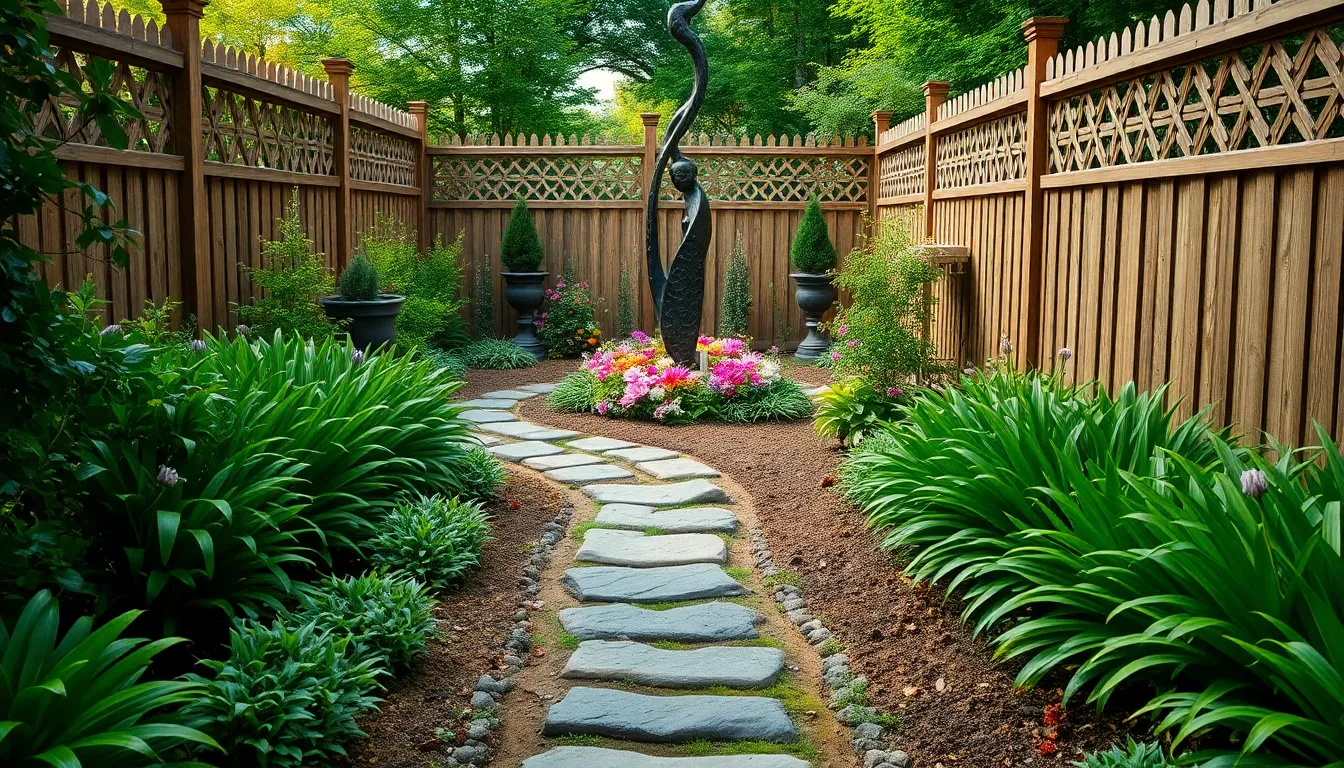
Hardscaping transforms our outdoor spaces by introducing built structures that provide both function and visual definition to garden areas. These elements create lasting structure that complements our plantings while establishing clear zones for different activities.
Add Pathways and Stepping Stone Walkways
Pathways guide visitors through our garden spaces while creating natural flow between different areas. We can construct these walkways using various materials including stone, pavers, or gravel depending on our desired aesthetic and budget. Stepping stone walkways offer a natural, rustic appearance that blends seamlessly with surrounding landscaping elements.
Integrating stepping stones with bordering plants and shrubs creates a cohesive design that feels intentional rather than imposed. These pathways work particularly well in informal garden settings where we want to maintain an organic feel. Materials like flagstone or fieldstone provide durability while weathering beautifully over time.
Install Garden Walls and Decorative Fencing
Garden walls serve multiple purposes in our outdoor spaces, acting as backdrops for plantings while providing privacy and wind protection. We can construct walls using materials like wood, stone, or metal to match our overall garden design theme. Retaining walls prove especially useful for creating tiered garden beds or stabilizing slopes in challenging terrain.
Decorative fencing enhances our garden’s aesthetic appeal while clearly defining property boundaries and garden zones. These structures allow us to incorporate climbing plants that soften hard edges and add vertical growing space. Privacy fencing creates intimate spaces perfect for meditation areas or outdoor dining zones.
| Hardscaping Element | Primary Materials | Key Benefits |
|---|---|---|
| Pathways | Stone, pavers, gravel | Guide movement, define spaces |
| Garden walls | Wood, stone, metal | Privacy, plant backdrop, slope control |
| Decorative fencing | Wood, metal, vinyl | Boundary definition, climbing support |
Create Focal Points with Garden Sculptures
Garden sculptures add personality and visual interest to our outdoor spaces, serving as conversation starters and artistic expressions. We can place these elements in central locations where they naturally draw the eye and create gathering points within our garden design. Sculptures come in various materials and styles, allowing us to complement different garden themes from modern minimalist to traditional cottage styles.
Integrating sculptures with water features creates particularly striking focal points that combine visual and auditory elements. These combinations work well in meditation gardens or entertainment areas where we want to establish a exact atmosphere. Positioning sculptures strategically helps break up large planted areas and provides visual anchors throughout our garden space.
Plan Seasonal Garden Areas for Year-Round Beauty
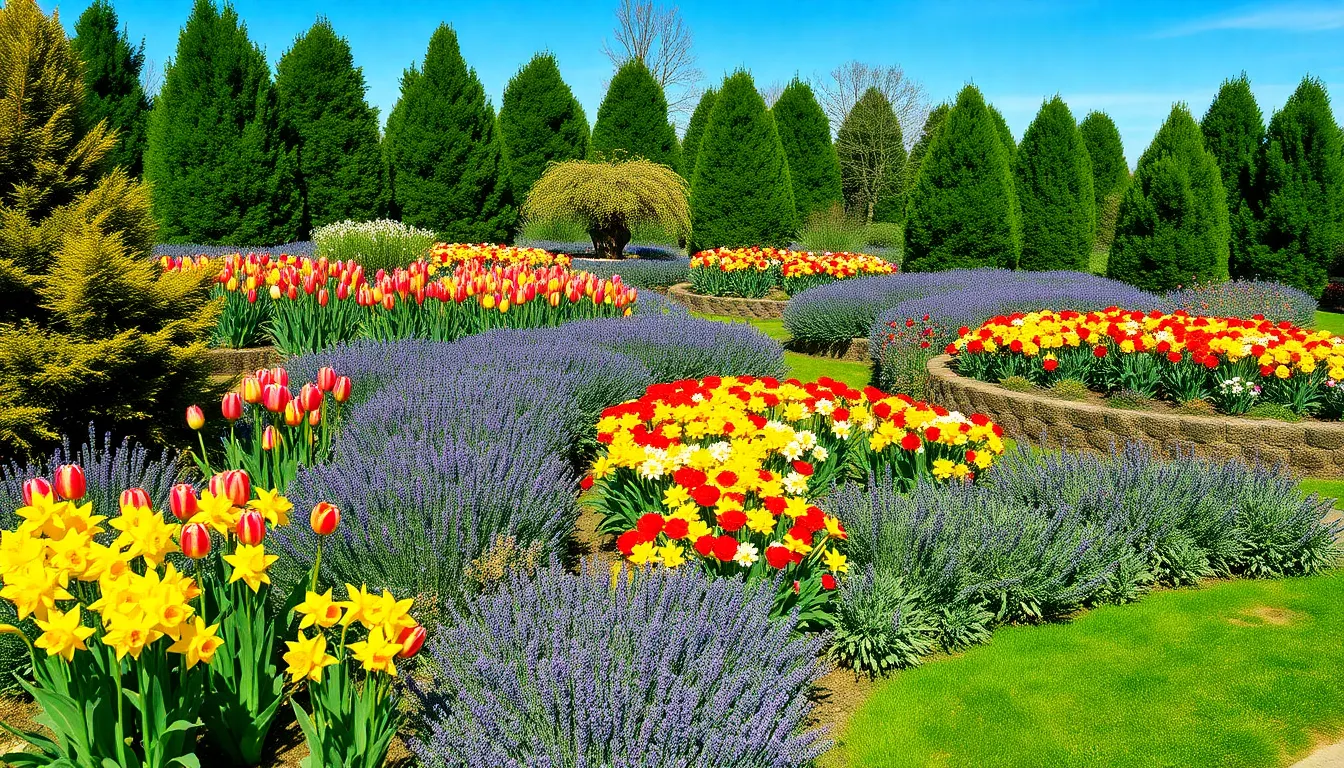
Creating garden spaces that maintain visual appeal throughout every season requires strategic planning and thoughtful plant selection. We’ll explore how to design distinct areas that transition beautifully from spring’s first blooms to winter’s structural elements.
Design Spring Bulb Garden Displays
Plant early blooming bulbs like daffodils, snowdrops, tulips, and hyacinths for the most vibrant spring garden displays. Starting your seasonal garden with these reliable performers ensures color when winter finally releases its grip. Combine these classic bulbs with anemones and ranunculus to create ever-changing spring transitions that capture attention from every angle.
Layer different bulb varieties at various depths to extend your blooming period. Position larger bulbs like tulips deeper in the soil while planting smaller crocus and snowdrops closer to the surface. This technique creates successive waves of color that keep your spring garden interesting for weeks rather than days.
Group bulbs in odd numbered clusters of 5, 7, or 9 for the most natural looking displays. Scattered individual bulbs often look lost in the industry, while clustered plantings create bold color statements that complement your existing garden structure.
Create Summer Perennial Flower Gardens
Select long blooming perennials like lavender, roses, and wisteria for extended summer garden performance. These powerhouse plants provide months of continuous color while requiring less maintenance than annual replacements. Lavender offers fragrant purple spikes that attract beneficial pollinators, while climbing roses create vertical interest against walls and arbors.
Add annual flowers like zinnias and marigolds to enhance summer color between perennial blooms. These fast growing annuals fill gaps quickly and provide intense colors that complement your established perennial framework. Zinnias bloom continuously in hot weather, while marigolds deter harmful insects naturally.
Create layered planting schemes with varying heights and bloom times for continuous garden interest. Place taller perennials like delphinium and hollyhocks in back borders, medium sized plants like peonies and day lilies in middle sections, and low growing perennials like coral bells and lamb’s ear along front edges.
Establish Four-Season Interest with Evergreens
Incorporate evergreen shrubs and trees like rhododendrons and winter daphne for year round garden structure and color. These backbone plants maintain visual weight during dormant seasons while providing shelter for wildlife. Rhododendrons offer spectacular spring blooms followed by glossy green foliage, while winter daphne provides fragrant flowers during cold months.
Add winter blooming flowers like violas, pansies, and hellebores for cold season garden beauty. These hardy performers thrive in cool weather when most other plants have finished their growing season. Hellebores, often called Christmas roses, bloom from late winter through early spring in shades of white, pink, and deep burgundy.
Position evergreens strategically to create garden rooms and define seasonal planting areas. Use larger evergreen specimens as living walls that separate different garden themes while providing consistent visual anchors. Smaller evergreen shrubs work perfectly as transition plants between seasonal displays, maintaining garden structure when deciduous plants are dormant.
Plan for overlapping bloom times to maintain continuous garden vibrancy throughout every season. Schedule your plantings so that as one group of plants finishes blooming, another group begins its display cycle. This careful timing ensures your seasonal garden areas never look empty or neglected.
Conclusion
We’ve explored countless ways to transform your outdoor space into a stunning garden that reflects your personal style and meets your practical needs. From peaceful meditation retreats to productive vegetable gardens and space-saving vertical answers your possibilities are truly endless.
The key to successful garden design lies in blending functionality with beauty while considering your exact space constraints and lifestyle requirements. Whether you’re working with a sprawling backyard or a compact urban plot these ideas can be adapted to create the perfect outdoor sanctuary.
Remember that great gardens evolve over time so don’t feel pressured to carry out everything at once. Start with one area that excites you most and gradually expand your vision. With thoughtful planning and creative execution you’ll soon have neighbors asking for your gardening secrets.
Frequently Asked Questions
What are some budget-friendly ways to transform my outdoor space?
You can create stunning garden transformations without breaking the bank by using container gardens, planting easy-to-grow vegetables in raised beds, and incorporating vertical gardening with trellises. Focus on native plants that require minimal maintenance, repurpose materials for pathways, and start small with one themed area before expanding your garden design.
How can I make my small urban garden more functional?
Maximize small spaces through vertical gardening using walls and trellises, create multi-purpose areas like reading nooks that double as herb gardens, and use tiered planting systems. Container gardens allow seasonal changes, while raised beds provide better organization and accessibility in compact areas.
What plants require minimal maintenance for busy homeowners?
Low-maintenance options include succulents for dry areas, native plants adapted to your climate, and perennials like lavender and ornamental grasses. Leafy greens, herbs, and root vegetables are easy-to-grow options for edible gardens. These plants typically require less watering and care while providing reliable results.
How do I create a meditation garden in my backyard?
Design a peaceful retreat using calming plants like lavender and bamboo, add water features such as small fountains for soothing sounds, and create secluded seating areas with natural materials. Incorporate privacy elements like tall grasses and use stepping stone pathways to guide movement through the space.
What are the benefits of raised bed vegetable gardens?
Raised beds provide excellent drainage, better soil control, and easier access for planting and harvesting. They allow for strategic crop rotation, prevent soil compaction, and create organized growing spaces. You can customize soil nutrients for specific plants and enjoy higher yields in smaller areas.
How can I attract wildlife to my garden?
Plant native species that provide natural food sources, install bird baths and feeding stations, and create multi-layered plantings that mimic natural ecosystems. Design butterfly gardens with nectar-rich flowers, provide shelter with dense shrubs, and avoid pesticides to create a wildlife-friendly environment.
What’s the best way to ensure year-round garden beauty?
Plan for seasonal interest by selecting plants with different bloom times, incorporate evergreen plants for winter structure, and layer spring bulbs for early color. Choose long-blooming perennials, add seasonal annuals, and ensure overlapping bloom periods to maintain continuous visual appeal throughout the year.
How do I choose the right theme for my garden area?
Consider your personal style, available space, and maintenance preferences. Japanese Zen gardens emphasize simplicity and natural elements, English cottage gardens feature colorful perennials and rustic charm, while modern minimalist designs focus on clean lines and contemporary materials. Choose themes that complement your home’s architecture.

